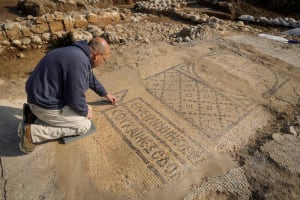Israel’s cement industry in light of Ezekiel 36:10-11

The rise of essential industries in Israel paralleling the nation’s reinstatement is evidence of providence, especially the case of cement in the building industry. Cement is the fundamental constituent of concrete, and concrete is integral to modern construction, essential for the booming reinstated nation on Israel. Nesher Israeli Cement has production plants (cement mills) in Ramla and Haifa [1], though clinker production is consolidated at Ramla where there are two dry-process kiln lines [2]. Production of clinker, the precursor to cement, is very energy intensive. The Ramla complex has its own natural gas power plant for production operations [2].
History
Cement has been one of the most significant industries in Israel. In 1949 Israel had one cement plant, the Nesher Works near Haifa, but by 1953 Nesher had three cement plants in operation [3]. These met the cement needs of Israel’s building industry and substantial quantities of cement were exported [3]. Ramla’s first dry kiln line began operation in 1995 and the second began operation in 1999 [4]. Currently Nesher produces about 60% of the market share for cement in Israel’s building industry [1], with market competition coming from imported cement and milling of imported clinker [5]. Population in Israel is increasing at a rate of about 1.7% per year, which is about 150,000 people annually, and therefore the building industry is in fact booming to accommodate [5].
Processing
Three major factors in cement production are equipment technology, fuel type, and raw materials. The Ramla kiln lines are modern and high-efficiency with five-stage preheater/precalciner configurations. For fuel, the Ramla kiln lines use petroleum coke (petcoke), imported from the United States [4]. Petcoke has high energy content [4] and is therefore favorable for energy-intensive cement production [6]. The drawback of petcoke is relatively high sulfur content [6]. The fate of sulfur is either sulfur dioxide emissions from the kiln, or as sulfates content in the clinker [7]. At the Ramla production lines, which were designed and modified for optimal use of petcoke fuel, most of the sulfur becomes sulfates in the clinker, at an acceptable 0.86% of the clinker composition [4]. Raw material is soft limestone sourced from the nearby Nesher-Ramla Quarry [8]. The soft limestone is easily quarried and efficient for grinding. Fly ash is used as an additive [9] to supplement limestone as a source of calcium oxide [10].
Biblical Narrative
Ezekiel 36:10-11 prophesied that Israel would experience what is referred to in modern terminology as a building boom; that is, a noteworthy population increase and corresponding building activity. Furthermore, according to Ezekiel 36:11, Israel would prosper more than it did in ancient times. It goes on to say “Then you will know that I am the Lord.” This reoccurring phrase in the book of Ezekiel means that realizing these occurrences is empirical evidence for knowing that He is the Lord (Yahweh, in Hebrew). This article is the fifth in a series about prosperous essential industries in modern-day Israel as a testament of providence and in fulfillment of prophecy.
References
[1] Tenable, Inc. 2020. Nesher Cement Secures Complex SCADA Environment from Cyber Threats.
[2] Doctori, G. Nesher Israel Cement Enterprises – Upgrading software systems. Contel Technologies.
[3] Israel, 1954. Israel Office of Information.
[4] Kaplan, E. and N. Nedder. 2001. Petroleum Coke Utilization for Cement Kiln Firing. IEEE Cement Industry Technical Conference, 251-263.
[5] McCaffrey, R. 2023, October. Intercem Instanbul. Global Cement Magazine, 74-78.
[6] Stockman, L., D. Turnball and S. Kretzmann. 2013. Petroleum Coke: The Coal Hiding in the Tar Sands. Oil Change International.
[7] Turnell, V. J. 2000. Fuel Changes in Cement Kiln Applications. APCAC XVII Technical Conference.
[8] Melamed, A. 2022. A New Perspective on the Research of the Underground Complexes in Light of the Excavations at Nesher-Ramla Quarry. Jerusalem Journal of Archaelogy 3(2): 164-207.
[9] Lieberman, R. N., E. Lederman, I. Pelly, and H. Cohen. 2014. Fly Ash as a Potential Scrubber of Acidic Wastes from the Phosphate Industries. Coal Combustion and Gasification Products Journal
[10] van Oss, H. G. 2005. Background Facts and Issues Concerning Cement and Cement Data, Open-File Report 2005-1152. United States Geological Survey (USGS).

Josh Bowditch is an aspirer of stewardship in the Biblical sense. This includes ascertaining the truth and writing concisely about topics of interest.
You might also like to read this:

















